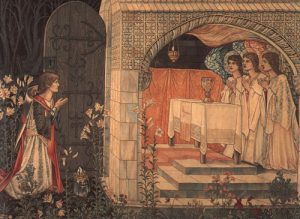
In Wolfram von Eschenbach’s Parzival, a tale from the Arthurian canon, a sorceress named Cundrie plays a pivotal role in the plot. She first appears to chide Parzival (Percival) for failing in his task to attain the Grail. She is described as a maiden no knight would ride for: hideously ugly. She has the ears of a bear, the fingernails of a lion, the hands of a monkey, incisors like boar tusks, and a nose like a dog. She is apparently a young woman, however, because her hair, coarse like a pig’s bristles, is black.
Wolfram tells us that Cundrie’s beastly qualities were given to her as punishment for Adam’s sins, yet she is not debased in her dress and education. Despite her homely appearance, she is richly dressed in the finest silks. She is a learned woman, fluent in many languages, including Arabic. In the Middle Ages, Arabs had a reputation as exceptional scholars, especially in astronomy and mathematics, subjects we are told Cundrie has mastered. Despite her aristocratic bearing, Cundrie arrives on a mule, not a horse.
Cundrie represents wisdom in her encounter with Parzival, upbraiding him for not asking an important question. She later dispenses a healing potion. Though her animal qualities are characterized as sinful, pre-Christian Celtic-Germanic beliefs held the boar, bear, lion, and hound as particularly sacred. (The monkey doesn’t seem to fit, though.)
Cundrie is a puzzle. She seems like she may be a shape shifting animal goddess demoted to an ugly maiden cursed by God to appeal to Christian sensibilities. She retains her function as guardian of knowledge.
